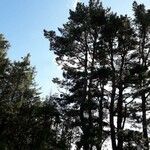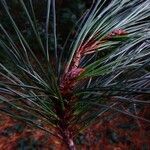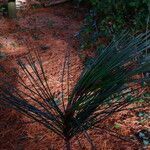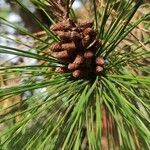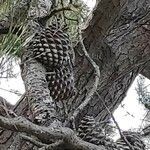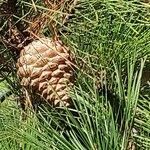Medium-sized to very large tree; habit variable, generally ± spreading, with foliage in dense terminal clusters. Bark thick, deeply fissured and ridged in mature trees, dark grey on surface, reddish brown beneath. Shoots brown or greyish brown, occasionally somewhat glaucous when young, glabrous. Buds cylindric or cylindric-ovoid, thinly resinous; scales appressed, chestnut-brown. Lvs 3 per fascicle, (3)-6-15 cm × 1.2-2 mm, deep or dark green, ± spreading, moderately rigid; resin canals median; sheath initially long but rarely > 1 cm long on mature lvs, persistent. ♂ strobili 0.7-1.5 cm long, cylindric. Conelets stalked, cylindric, scales with short mucro. Mature cones sessile or subsessile, 1-c. 6 in a cluster, backward pointing but not pendent, long-persistent, eventually falling intact, 6-13 × 4.5-8.5 cm when closed, ± ovoid, brown at maturity; base asymmetric; apophyses on upper side enlarged and rounded; umbo usually not armed at maturity. Seed wing ± oblong, only slightly wider towards apex, 1.5-2 cm long.
Tree, 25-40 m high, straight; bark deeply furrowed into broad flat ridges, covered with thick appressed scales, black-brown. Crown formed from 1-many erect stems, profusely branched. Leaves: (2)3 needles per fascicle; fascicle sheath persistent, 8-12 mm long; needle 50-150 mm, rather slender. Spring shoots multinodal. Branchlets brown, glabrous. Cones spreading, 1-5 in a whorl, indehiscent, serotinous, persistent, sometimes for 40 years, sessile or shortly pedunculate; shiny light brown, very asymmetrical, obliquely ovoid-conical, 70-150 x 60-120 mm; lower scales ending almost flattened, obscurely keeled. Seeds 6 mm long, blackish, winged.
Tree to 35 m tall. Bark dark brown, persistent, broken into deep irregular ridges. Resting buds ovoid to cylindrical, 12-20 mm long, brown, non-resinous, with entire, closely appressed, deciduous scales. Leaves glossy, green, finely toothed, 10-15 cm long, in bundles of 3, lacking resin canals or sometimes with 2 medial resin canals, with stomatal lines on all sides; basal sheath 10-15 mm long. Female cones solitary or clustered, ovoid, strongly asymmetric, 6-15 cm long, sessile or shortly pedunculate, pendulous, persistent on tree for 1-several years after maturity; scales ovate, rounded. Seeds with a well-developed wing.
Up to 40 m; bark becoming thick, fissured, dark brown. Buds ovoid-cylindrical, resinous. Twigs glabrous, reddish-brown. Basal sheath of short shoots less than 15 mm. Leaves 100-150 mm, in threes, slender, acute, densely crowded; resin-canals median. Cone 7-14 x 5-8 cm, ovoid-conical, very asymmetrical, sessile or shortly stalked, deflexed; apophyses on upper side of cone rounded; umbo with small caducous mucro. Seed c. 7 mm; wing c. 20 mm.
Monoecious, conical to rounded tree to 30 m, Leaves needle-like, 60-150 mm long, in bundles of (2)3, dense and slender, dark green. Cones strongly asymmetrical, obliquely ovoid, scales short and thick, apiculate.
An evergreen tree. It grows up to 65 m tall and spreads 10 m wide.
